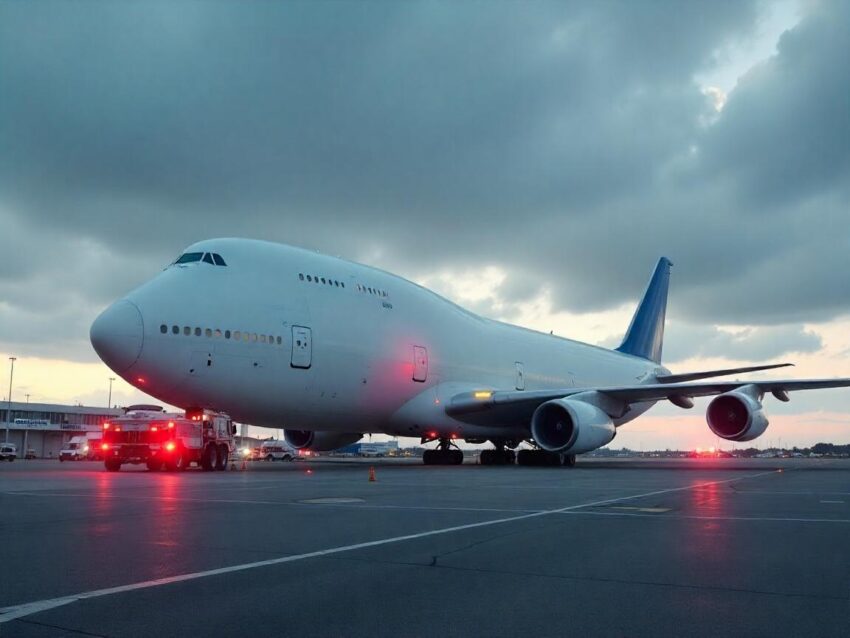
Airbus BelugaXL emergency landing in Toulouse sparks an urgent safety spotlight and raises questions about the future of oversized cargo operations, sending ripples through the aviation world. Meanwhile, skies that once seemed predictable are now charged with uncertainty as this giant aircraft faces unexpected challenges. However, the Airbus BelugaXL emergency landing isn’t just another headline—it’s a moment that could reshape Toulouse’s role and redefine oversized cargo operations across Europe.
Moreover, the incident sparks intense curiosity about what truly happened and whether deeper issues might lie hidden within Airbus’s prized fleet. Why did the BelugaXL divert so suddenly? What secrets does Toulouse now hold? How might this incident influence the future of oversized cargo operations worldwide? Questions multiply, urgency escalates, and the aviation industry watches every move. The Airbus BelugaXL stands at the center of a mystery—and the answers could transform how the world moves its largest cargo through the skies.
BelugaXL: The Gentle Giant of the Skies
The Airbus BelugaXL isn’t your typical cargo aircraft. Based on the A330-200, it stretches longer, stands taller, and carries outsized loads other jets simply can’t manage.
It was created to shuttle enormous parts—fuselages, wings, stabilizers—between Airbus’s sprawling production sites in places like Hamburg, Toulouse, and Broughton. This logistical ballet keeps global aircraft assembly lines humming.
Moreover, the BelugaXL replaced the older A300-600ST Belugas, which had been in service for decades. With increased capacity and modern systems, the XL promised greater efficiency and flexibility for Airbus’s operations.
The Incident That Shocked Toulouse
The flight in question, designated BGA163H, departed Madrid at 10:30 UTC. Thirty minutes into the journey, the crew faced a serious problem—a depressurization warning at cruising altitude.
Within moments, the aircraft descended from 30,000 feet to 10,000 feet, a rapid drop designed to keep crew and systems safe. Meanwhile, the pilots declared an emergency, setting a course for Toulouse, Airbus’s home turf and a natural haven for troubleshooting.
At 11:40 UTC, the BelugaXL touched down safely in Toulouse. No injuries were reported, but the aircraft remained grounded as engineers began urgent inspections.
A Second Scare in Less Than a Year
This wasn’t the first time a BelugaXL faced such an ordeal. On September 10, 2024, another BelugaXL diverted to Amsterdam Schiphol Airport after suffering a similar pressurization scare mid-flight over Belgium.
That aircraft, registered as F-GXLI, had been en route from Saint-Nazaire to Hamburg. Like this latest incident, the crew declared an emergency and descended rapidly, ultimately landing safely.
Two pressurization issues in under a year raise concerns, igniting debate within aviation circles about potential systemic issues in the fleet or simply unlucky coincidences.
The Hidden Complexity of Oversized Cargo Operations
Flying enormous aircraft parts isn’t merely about big planes and big cargo doors. It’s a finely tuned dance requiring unique engineering, specialized training, and meticulous safety protocols.
The BelugaXL’s unusual fuselage design demands precise pressurization management, given its balloon-like upper fuselage housing outsized cargo. Any pressurization fault could stress the airframe in ways that conventional freighters might not experience.
Meanwhile, cargo flights like these are critical lifelines for Airbus. A single delayed part can disrupt entire aircraft production lines, costing millions in lost time and contracts.
Airbus’s Fleet Strategy in Flux
The Beluga story is intertwined with Airbus’s evolving business model. In the 1990s, Airbus relied on the A300-600ST Beluga to replace the aging Aero Spacelines Super Guppy. The first Beluga flew in 1994 and revolutionized Airbus logistics.
However, as Airbus production volumes surged, the need for even larger capacity gave birth to the BelugaXL program, based on the A330-200 platform. The BelugaXL entered service in 2020 and gradually assumed the original Beluga’s internal transport duties.
In a bold move, Airbus launched Beluga Transport in January 2022, offering the original Belugas for commercial oversized cargo operations. Yet, that experiment lasted barely a year before Airbus pulled back to focus the fleet solely on internal operations.
Why Toulouse Was the Perfect Haven
Toulouse wasn’t just the nearest runway—it’s Airbus’s heart. The city houses major manufacturing plants, engineering teams, and logistical support for the Beluga fleet.
By diverting to Toulouse, the crew ensured the aircraft could be examined immediately by specialized teams who know the Beluga’s unique systems inside and out. It minimized downtime and kept sensitive cargo operations as secure as possible.
Rolls-Royce Power and the Technology Behind the BelugaXL
The BelugaXL involved in the emergency, registered F-GXLH, is powered by two Rolls-Royce Trent 700 engines. At just over six years old, it’s among the newer members of Airbus’s specialized fleet.
Its advanced systems and robust engines highlight the balance between modern aviation technology and the bespoke challenges of oversized cargo operations.
Impact on Airbus Production and Global Aviation
Incidents like this create more than just headlines—they ripple through the aerospace industry. Every BelugaXL flight transports vital components, some irreplaceable on short notice.
A grounded aircraft disrupts meticulously planned production schedules for aircraft like the A320neo or A350, potentially delaying deliveries to airlines worldwide. As demand for new aircraft surges post-pandemic, any operational hiccup becomes even more critical.
The post Airbus BelugaXL Emergency Landing in Toulouse Sparks Urgent Safety Spotlight and Raises Questions About the Future of Oversized Cargo Operations appeared first on Travel And Tour World.from Travel And Tour World https://ift.tt/jfThLES
via >EPR


